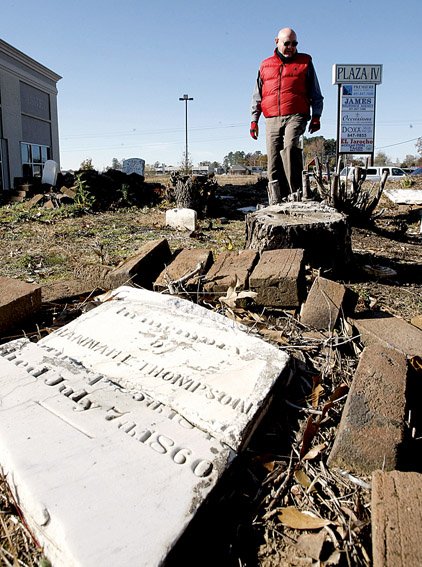BRYANT - George Gatliff walked across a leaf-covered hill next to a strip mall and pressed his foot down on a small, partly buried rock.
"It's solid," the 78-year-old amateur archaeologist said, confident he'd found another spot in an unkept cemetery where Arkansas pioneers were laid to rest.
After five years of tramping around the backwoods of western Arkansas looking for abandoned cemeteries with his friend Meeks Etchieson, it takes little more than a slight depression in the dirt or a curiously placed rock to tell Gatliff he's on hallowed ground.
The two are grave hunters, out to record a bit of history and maybe even prevent it from being demolished by modern conveniences.
They have documented a couple of dozen abandoned cemeteries and family grave sites, mostly in Pike and Clark counties, where many of their ancestors lived and died.
Gatliff, a Little Rock retiree, and Etchieson, a forest archaeologist from Magnet Cove, photograph the graves, draw detailed maps and turn in their findings to the Arkansas Archeological Survey.
"If we do our paperwork correctly, 50 or 100 years from now somebody can walk right up tothat spot," Gatliff said. "In the meantime, it may be covered up by a gasoline station or something like that."
Along with other volunteers across the state who pursue the hobby, the duo is an integral part of making sure that lost cemeteries are found and not forgotten, archaeologists said.
"There are only so many of us who are doing this in the survey as professionals," said Mary Beth Trubitt, an archaeologist with Henderson State University. "We rely on these volunteers because they get out and are able to do all this work and help us."
Gatliff and Etchieson are particularly helpful, she said, because they have devised a detailed way of keeping records and are knowledgeable about headstones and burial practices.
Their work is part of a nationwide trend of preserving history by protecting grave sites potentially threatened by rural development. The effort has picked up steam in Arkansas over the past five years and can be as important as pottery or tools in understanding the state's past, said state Archeologist Ann Early, who heads up the survey.
"It became apparent that more cemeteries were at risk, and it was to our benefit to know where they were to share that information with developers and other people," she said. " It'srescuing a little bit of Arkansas history."
To Gatliff and Etchieson, some cemeteries are more intriguing than others.
Gatliff has made several trips to a Civil War-era cemetery off Arkansas 5 in Bryant to look at an hourglass-shaped grave outlined with crudely made bricks. Underground, the tombstones say, lie the Kirkpatricks, one of Bryant's pioneer families.
Gatliff posted information about the cemetery on a genealogy Web site, which led to inquiries from people across the country who think they are related to the Kirkpatricks.
His work helped Patsy Kuhn of Bryant connect with her roots.
A descendant of the Kirkpatricks, Kuhn wanted to unearth her family's history. It was only after learning about the graves Gatliff had documented that she was able to dig deep, ultimately tracing her heritage to Scotland.
"He actually knew more about my family than I did," she said.
Now, Kuhn is working witha local historical society to get the cemetery recognized as a national historic site.
Etchieson, 57, first got involved with documenting Clark County sites in the 1990s, when the historical society there was updating its cemetery book and needed people to wander into the wilderness to find remote sites.
Eventually Gatliff joined up, and now the two go on adventures whenever they can, unless Etchieson's "wife has something for him to do," Gatliff joked.
A tip about a possible tombstone in the countryside can send them on a hunt.
"We look for a lot more than we actually find," Etchieson said modestly.
On one trip, the pair had trekked about 50 yards off a country road in eastern Pike County when Gatliff found himself standing in front of a "rock and an armadillo hole."
"I looked around, and I was standing right in the middle of a grave. I hollered, 'Meeks, get your butt up here and see what I've found,'" Gatliff said.
He learned that the area was the Huffman homestead in 1850, but by the next census the familyhad vanished. It's hard to know for sure who lay under the armadillo hole, but Gatliff used his "vivid imagination" to paint a theory: "This little family got sick and all died before 1860."
Arkansas, Pages 13, 22 on 12/26/2008
